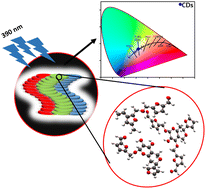White light emission from helically stacked humin-mimic based H-aggregates in heteroatom free carbon dots†
Abstract
White light emission (WLE), particularly from heteroatom free carbon dots (CDs), is unusual. Besides, deciphering the origin of WLE from a H-aggregated molecular fluorophore in such kinds of CDs is a challenging task due to their non-fluorescent character resulting from a forbidden transition from a lower-energy excitonic state. Therefore, rigorous investigation on their elusive excited state photophysical properties along with their steady-state optical phenomena has to be carried out to shed light on the nature of distinct emissive states formed in the CDs. Herein, for the first time, we report WLE from imperfect H-aggregates of co-facially π–π stacked humin-like structures comprising furfural monomer units as a unique molecular fluorophore in CDs, as revealed from combined spectroscopic and microscopic studies, synthesized through hydrothermal treatment of the single precursor, dextrose. H-aggregates in CDs show a broad range of excitation-dependent emission spectra with color coordinates close to pure white light, i.e., CIE (0.35, 0.37) and a color temperature of 6000 K. Imperfect orientation between the transition dipole moments of adjacent monomer units in the H-aggregate's molecular arrangement is expected to cause ground state symmetry breaking, as confirmed by Circular Dichroism (CD) studies, which established helically stacked nature in molecular aggregates and produced significant oscillatory strength at lower energy excitonic states to enable fluorescence. TRES and TAS investigations have been performed to minimise the intricacies associated with excited state photophysics, which is regarded as an essential step in gaining a grasp on emissive states. Based on the observation of two isoemissive spots in the time-resolved area normalized emission spectra (TRANES), the existence of three oligomeric species in the excited state equilibrium of the pure/hybrid H-aggregates has been established. The exciton dynamics through electron relaxation from the higher to the lower excitonic states, charge transfer (CT) states, and surface trap mediated emission in excimer states of H-aggregates have also been endorsed as three distinct emissive states from femtosecond transient absorption spectroscopy (TAS) studies corroborating with their steady-state absorption and emission behavior. The results would demonstrate the usage of CDs as a cutting-edge fluorescent material for creating aggregate-induced white light emission.



 Please wait while we load your content...
Please wait while we load your content...